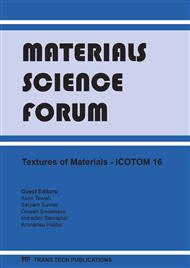p.463
p.469
p.475
p.479
p.485
p.489
p.493
p.499
p.507
Evaluation of Geometrically Necessary Dislocations Density (GNDD) near Phase Boundaries in Dual Phase Steels by Means of EBSD
Abstract:
The accumulation of dislocations around hard particles such as martensite in Dual Phase steel has a prominent influence on the mechanical properties of multiphase steels. The origin of these so-called Geometrically Necessary Dislocations (GNDs) is either due to the transformation strain, or to strain gradients that arise during deformation. The generation of deformation-GNDs is explained by Ashby’s theory [1] regarding deformation of a plastic mass that contains dispersed undeformable particles. It is argued that the GNDs pile up locally against the ferrite-martensite interface. This work reports the calculated density of GNDs from high resolution Electron BackScatter Diffraction (EBSD) measurements. By measuring the lattice orientation within the grains, the lattice curvature can be quan-tified, which can be directly related to the presence of GNDs. The density of the GNDs can then be estimated either directly through kernel average misorientations, or through the calculation of the dislo-cation tensor. From this first approximation of the GND density a GNDD map has been obtained by two recently developed approaches. This map shows an enhanced dislocation density around the mart-ensite particles due to volume change during transformation. The kernel choice and step size depend-ency of the results are also investigated.
Info:
Periodical:
Pages:
485-488
Citation:
Online since:
December 2011
Keywords:
Price:
Сopyright:
© 2012 Trans Tech Publications Ltd. All Rights Reserved
Share:
Citation:


